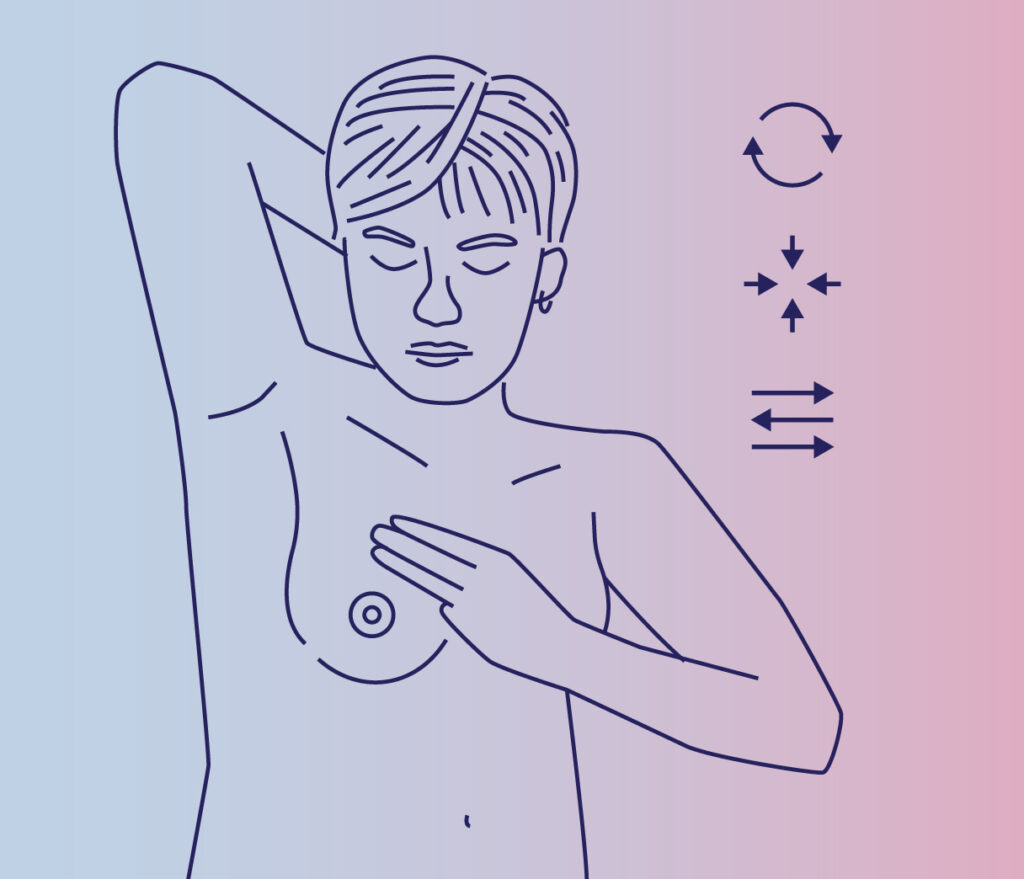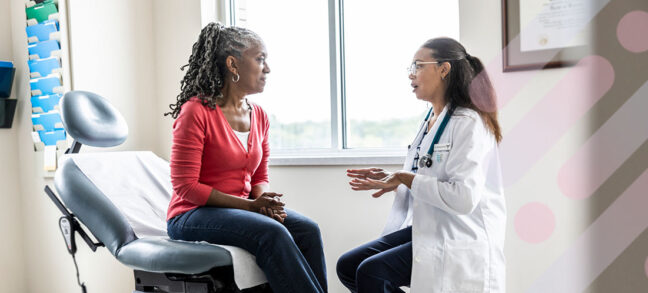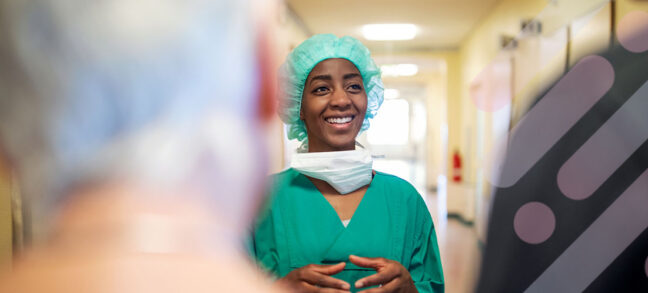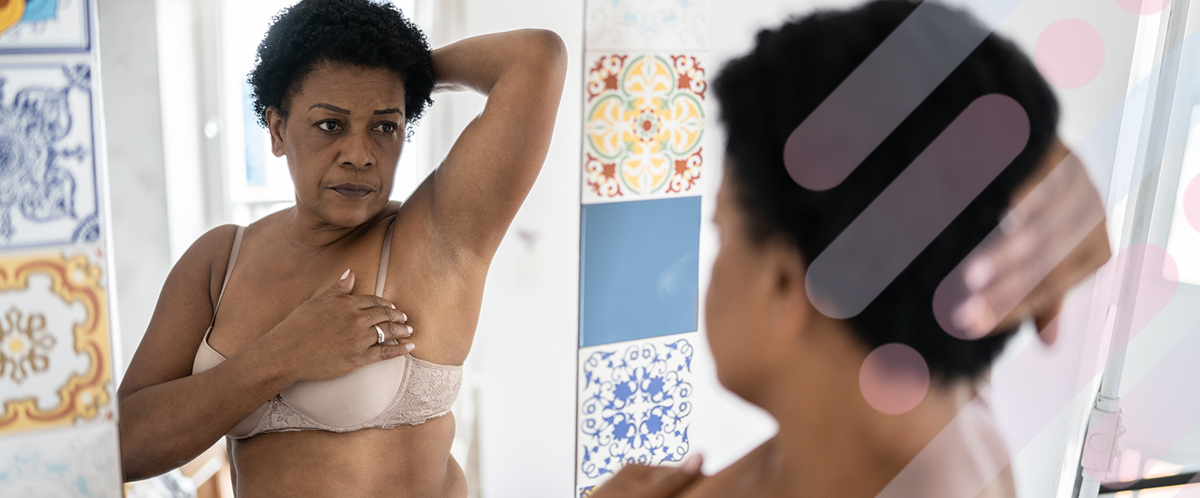Breast cancer accounts for about 30% of all new cancer cases in women each year in the United States. It is the most common cancer in the world.
Early detection is key when it comes to cancer of any kind. With breast cancer, monthly self-exams offer an opportunity to identify a baseline and monitor for any changes that may be cause for concern.
According to the CDC, the following symptoms might be a sign of breast cancer:
- Any change in breast size or shape
- Appearance of lump(s) in the breast or underarm
- Swelling in the breast or underarm area
- Skin irritation or dimpling
- Red or flaky skin in the nipple or surrounding area
- Sunken nipples or pain in the nipple area
- Any discharge other than breast milk, including blood
- Pain in any area of the breast
- Skin warm to the touch
If you experience or notice any of these symptoms, it’s important to see your doctor for further testing and screening.
When to start performing breast self-exams
Breast self-exams can and should start much earlier than 40 years old, the age when women are told to start scheduling mammograms.
This is especially true if you have a history of breast cancer in your family. Many doctors suggest starting breast self-exams around the age of 20 and continuing on through menopause. A woman’s risk of breast cancer nearly doubles if she has a first-degree relative (mother, sister, daughter) who has been diagnosed with breast cancer. Approximately 15% of women who get breast cancer have a family member diagnosed with it.
The American Cancer Society offers the following guidelines for when women should start medical screening for breast cancer with mammograms:
- Women between 40 and 44 have the option to start screening with a mammogram every year.
- Women 45 to 54 should get mammograms every year.
- Women 55 and older can switch to a mammogram every other year, or they can choose to continue yearly mammograms. Screening should continue as long as a woman is in good health and is expected to live at least 10 more years.
A breast self-exam is a useful tool for the early detection of breast cancer, but this at-home monitoring should not take the place of regular mammograms and clinical breast exams.
How to perform a breast self-exam
For women still menstruating, a breast self-exam should be performed a few days after her period ends. For those who are pregnant or post-menopausal, a breast self-exam should be performed on the same day of each month, such as the 1st or 15th day of the month. Setting a calendar alert or writing a reminder on a sticky note and leaving it on the bathroom mirror will help you stay consistent with your schedule.
A self-exam can happen in the shower, in front of the mirror or lying down.
In the shower or in front of the mirror: Raise your arm over the top of your head in order to flatten and maximize the surface area of your breast.
When lying flat: Place a pillow under the side you are examining and raise your hand over your head in order to flatten and maximize the surface area of your breast.
To perform the exam, follow these steps:

- Bring your pointer, middle and ring fingers together and use a light but firm touch to apply pressure on your right breast.
- You can move in circles radiating out from the nipple.
- You can move from one side to the other starting at the top and working your way down to the bottom of the breast.
- You can start from the outermost part and move in toward the center.
- Be sure to feel the area from your collarbone to the bottom of your ribs, as well as under your armpit. This is where your lymph nodes exist. Swollen lymph nodes are often an indication to go see your doctor. They will feel like small bumps that are tender or painful when touched.
- While you are moving your fingers about, take note of anything unusual or uncomfortable.
- Repeat the same steps on the left breast.
If you notice anything out of the ordinary during your exam, be sure to reach out to your primary care practitioner. They will be able to help you more accurately confirm symptoms and guide you to the next steps that are best suited for your needs.
additional resources for self-exam education
National Breast Cancer Foundation
Resensation patient: Jessica’s story
Resensation patient: Stephanie’s story (from Atlanta)
Resensation patient: Stephanie’s story (from Texas)
Some links will navigate you away from the Resensation website. Links outside of resensation.com are provided as a resource to the viewer, and do not constitute an endorsement or recommendation by Axogen. Axogen accepts no responsibility for or control over the content of the linked sites.
Resensation Blog

How does mastectomy impact the nerves in the breast?
One sometimes overlooked aspect of mastectomy is its impact on nerves. Read what happens to nerves during mastectomy and explore…
Read More
What happens during implant breast reconstruction with Resensation®?
By repairing sensory nerves, Resensation® enables you to potentially regain sensation to your chest. Read how this procedure works during…
Read More
how resensation® helped Leanna feel secure in her family’s future
With Resensation®, Leanna can be there to watch her kids grow up—without losing the feeling of being whole.
Read More
sensory retraining: what is it, and how can it help me after resensation®?
Sensory retraining is a series of exercises designed to help you reconnect with your body after breast reconstruction with Resensation®.
Read More